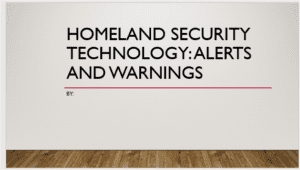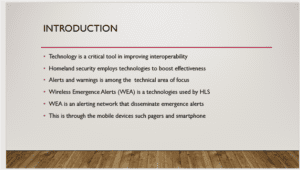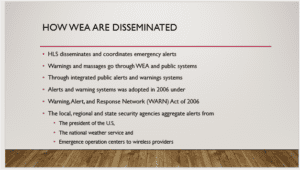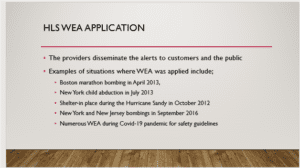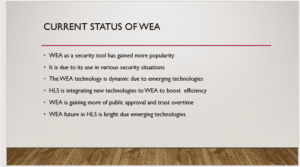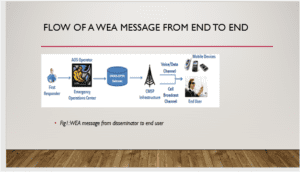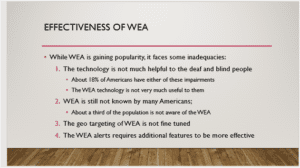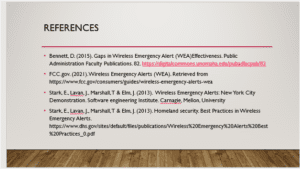Homeland security technology- Alerts and warnings 
Technology is a critical tool in improving the interoperability of operations in different organizations. It is an enabler that makes work more efficient and tends to save time and resources. The Department of Homeland Security, like many other organizations, employs technologies to boost the effectiveness of its operations. Alerts and warnings are among the technical areas of focus that Homeland Security focuses on in maintaining and ensuring peace within the U.S. borders (Bennett, 2015). The Wireless Emergency Alerts (WEA) is a technology used by the Department of Homeland Security to communicate to the public concerning certain occurrences that could be a threat to the security of society. WEA is an alerting network that disseminates emergency alerts to inform the public to take precautionary measures against an occurrence that could threaten their lives (FCC.gov, 2021). WEA messages are transmitted through mobile devices such as pagers and smartphones to the end-users. A large percentage of the American population nowadays relies on the WEA services to know what is happening around them and when they get such a message, they act quickly to prevent the damages that may come with the occurrence.
The Department of Homeland Security (DHLS) collects and coordinates emergency alerts from various sources and disseminates them to a specific target population. Not all of the American population receives alerts from the HLS but the targeted population does. For example, when there is a threat of a Hurricane along the coast, the HLS would only direct the alerts to the people living in the regions likely to be affected by the Hurricane (FCC.gov, 2021). The warnings and messages go through WEA and public systems, and they get integrated into public alerts and warnings systems. The Alerts and warning systems were adopted in 2006 under the Warning, Alert, and Response Network (WARN) Act of 2006, an act that was necessary after the 9/11 attacks and was passed by Congress. The Homeland Security Agency source the alerts from different sources; some alerts come from the office of the president on matters of national concern (Bennett, 2015). Some alerts come from the National Weather Service, which usually updates the public on various weather issues. When there is adverse weather such as floods, hurricanes, or cold temperatures, the public is informed about precautions. Other alerts come from the emergency operation centres to wireless providers.
The wireless providers disseminate the alerts to customers and the public immediately after receiving the source’s alerts. This is because the alerts are supposed to inform the public about certain occurrences, and thus, the providers need not delay disseminating the information (Stark, Lavan, Marshall, & Elm, 2013). Examples of situations where WEA was applied in recent U.S history include; the Boston Marathon bombing in April 2013, the New York child abduction in July 2013, the Shelter-in place during Hurricane Sandy in October 2012, the New York and New Jersey bombings in September 2016 and the Numerous WEA during Covid-19 pandemic for safety guidelines (Bennett, 2015). In all these situations, the alerts inform many people about what is going on around them. The public is continuing to rely on such security alerts to know about what is happening around them. The improvement in the internet strength is helping this technology to grow and become even more popular.
The WEA security technology is a security tool that is gaining more popularity within the US society and even in the rest of the world. The contemporary world is full of disasters and public threats. Therefore, technologies such as WEA technology are one approach the security agents use to manage the situation and mitigate the threats (Stark, Lavan, Marshall, & Elm, 2013). The WEA technology is dynamic due to emerging technologies; more innovation is bringing new technologies that are being integrated into the system, making disseminating information even more efficient. HLS is incorporating new technologies into WEA to boost efficiency (Stark, Lavan, Marshall, & Elm, 2013). Thus, WEA is gaining more public approval and trust over time because of its role in society. Americans are getting used to the alerts, and most people appreciate this innovation because it is helping save lives and property. WEA’s future in HLS is bright due to emerging technologies
This diagram shows the flow of the security alert from the source which can be the office of the President, or the National Weather Service. The alert is remitted to the emergency operation centers who relay the message to the Commercial mobile service providers, who disseminate the message through the cell broadcasts channels to the mobile devices of the end users. The alert flow goes through this process instantly. Homeland security agencies use this process to alert the public on any event that is happening or is about to happen to advise them on what they ought to do.
Despite gaining more popularity, WEA is facing some inadequacies that lead to some ineffectiveness. First, this technology is not of much help to deaf and blind people because the alerts come in the form of sound messages on mobile devices (FCC.gov, 2021). Blind people cannot see what the message is saying, while the deaf cannot hear when the message alert comes. It is estimated that about 18% of Americans have either of these impairments; hence WEA technology is not valuable to them. Homeland security needs to develop another technology that would help inform people living with these disabilities.
The second inadequacy of WEA is that it is still not known by many Americans, especially the older generations (Bennett, 2015). The WEA technology is much known by the young generations, who often use their mobile devices, but the older generations are less in touch with their phones. Hence, older people are less likely to read the alerts even when they get the alerts on their mobile devices.
Another inadequacy of WEA technology is that about a third of the population is not aware of the WEA technology; HLS should create awareness of WEA alerts to the public and educate them on its importance (FCC.gov, 2021). Another shortcoming of the WEA technology is that the geo-targeting of WEA is not fine-tuned, meaning that there are inefficiencies in the communication. Lastly, WEA alerts require additional features to be more effective.
ORDER A PLAGIARISM-FREE PAPER HERE
We’ll write everything from scratch
Question
To provide your colleagues with a practical illustration of how HLS operates, pick a major technology initiative undertaken by the Department of Homeland Security since its inception in 2003, and create a presentation for your colleagues. In it, cover the following:
Homeland security technology- Alerts and warnings
Explain the initiative’s background and the purpose of HLS for undertaking the initiative.
Describe the current status of the program, and assess its effectiveness in relation to its objective.
Support your arguments with authoritative sources, and apply appropriate APA formatting guidelines.

